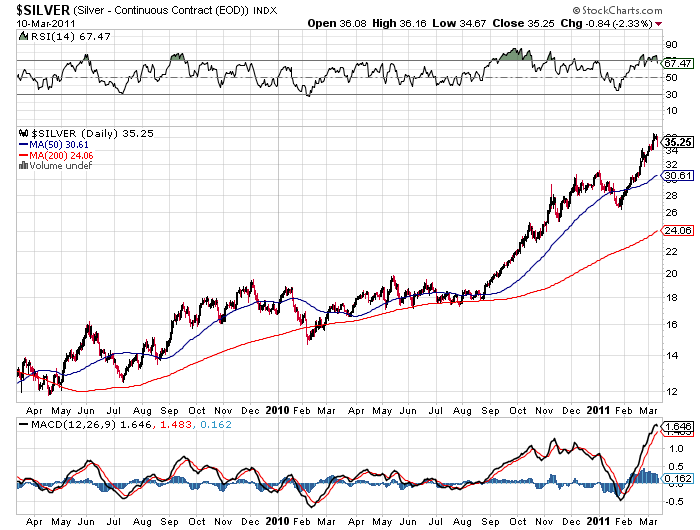 Gold and silver prices declined slightly on the week, as measured by the closing London PM Fix prices. Gold finished the week at $1,411.50 for a loss of $15.50 while silver declined fractionally by 33 cents to close at $34.10. However, as markets assessed the impact of a slowing world economy, higher inflation, higher oil prices and the massive earthquake in Japan, prices for gold and silver saw significant price improvement in late Friday New York trading. Gold moved up $9.20 to $1,421.30, while the silver price rose $.60 to $35.90.
Gold and silver prices declined slightly on the week, as measured by the closing London PM Fix prices. Gold finished the week at $1,411.50 for a loss of $15.50 while silver declined fractionally by 33 cents to close at $34.10. However, as markets assessed the impact of a slowing world economy, higher inflation, higher oil prices and the massive earthquake in Japan, prices for gold and silver saw significant price improvement in late Friday New York trading. Gold moved up $9.20 to $1,421.30, while the silver price rose $.60 to $35.90.
In a week of tumultuous economic and political news, platinum and palladium saw significant declines on the week as investors worried about reduced industrial demand in the face of a slowing world economy.
| Precious Metals Prices | ||
| Fri PM Fix | Since Last Recap | |
| Gold | $1,411.50 | -15.50 (-1.09%) |
| Silver | $34.10 | -.33 (-0.96%) |
| Platinum | $1,777.00 | -51.00 (-2.79%) |
| Palladium | $754.00 | -57.00 (-7.03% |
The minor price consolidation for gold and silver over the past week are impressive considering the strong gains of the previous month. Strong bull moves are never straight and price corrections should be seen as an opportunity to increase positions.
None of the concerns that have propelled the precious metals higher have been resolved. There is a strong probability that one or more of them will blow up putting major financial pressures on governments that are already staring into the abyss due to untenable levels of debt. Which event will trigger another financial crisis is impossible to predict, but here’s a quick rundown of the obvious suspects:
1.) The final implications of the massive Japan earthquake will take weeks to assess but is certain to add huge financial stress to a country already overwhelmed by the highest debt to GDP ratio in the world. The Japanese central bank has already indicated it is ready to loosen monetary conditions to calm financial markets, which may be a signal that they will follow the U.S. Fed’s lead and engage in a significant amount of quantitative easing or money printing. The cost of credit default swaps on Japanese government debt widened significantly reflecting the need for increased borrowings by a government already overwhelmed by indebtedness. As investors become increasingly alarmed at the prospects of default on government debt and currency debasement, the flight to gold will accelerate.
2.) The sovereign debt crisis in Europe continues to spiral towards a crisis as the European Central Bank attempts to solve a debt crisis with more debt. Monetary authorities worldwide are out of standard policy options and will follow the lead of the U.S. Fed by printing money. The implications of money printing on a global basis removes all constraints on the appreciation limits of the precious metals.
3.) The largest bond fund in the world dumps all longer dated U.S. Treasury securities. Bill Gross, manager of PIMCO, the largest bond fund in the world warns that when QE II stops in June, there will not be enough buyers for government debt, leading to a funding crisis for the U.S. Government. If one of the planet’s smartest and biggest bond investors thinks it’s time to sell U.S. Treasuries, the risk of contagion becomes substantial. Foreign governments currently purchase half a trillion dollars of U.S. debt every year and are becoming alarmed by Fed policies which make their debt investments look riskier by the day. How long will it be before other major investors in U.S. debt decide to follow Bill Gross’s lead and initiate a massive sell off in U.S. treasuries?
4.) Oil prices have pulled back in recent days but the situation remains volatile. A small group of protesters in Saudi Arabia were immediately dispersed with a hail of rubber bullets from security forces, an action that can only further inflame the passions of those who feel repressed by regimes in Saudi Arabia and other oil producing countries. Chaos in Saudi Arabia would quickly put the world economy back into an economic meltdown that governments may be unable to contain.

SILVER - COURTESY STOCK CHARTS.COM
The last upward move in silver last four months from September through the end of 2010 with a price gain of over 70%. After a brief correction early in the year, investor and industrial demand pushed silver to a new yearly high. A rally equivalent to that of last year would drive silver up to the $50 level by June.
Speak Your Mind